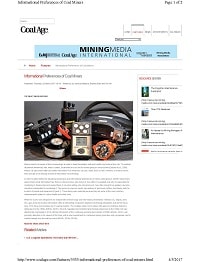Mining Publication: Informational Preferences of Coal Miners: The What, When and Who
Original creation date: January 2017
Authors: J Bellanca, B Eiter, TJ Orr
Miners need to be aware of their surroundings in order to keep themselves safe and healthy and reduce their risk. To maintain situational awareness, they need to detect, understand and act on the events going on around them (Endsley et al., 2000). Miners can get some health and safety information from what they can see, smell, touch or feel. However, in today's mines, they also get an increasing amount of information via technology. In order to better define the situational awareness and informational preferences of miners underground, NIOSH researchers asked miners what information they think is critical to know, who knows it, how often it is updated, and who is responsible for monitoring it. Researchers also asked them, in an ideal setting, who should know it, how often should it be updated, and who should be responsible for monitoring it. The survey focused on miners' perceptions of gas levels, airflow, dust levels, and the location of people and equipment. These items were selected because they are some of the most common measurements related to critical health and safety risks. While the survey was designed to be independent of technology and information presentation methods (i.e., display, alert, etc.), gas, dust and location information offer an interesting comparison related to technology integration and are the focus here. First, these technologies are of varying maturity. The multigas meter is the oldest, with approved methane detectors dating back to the 1950s (MSHA, 2015c). Second, regulated dust monitoring technology dates back to the 1980s, but was significantly overhauled in 2014 with the introduction of the continuous personal dust monitor (CPDM) (MSHA, 2014). Last, proximity detection is the newest of the three, with a new requirement for continuous mining machines and a proposed rule for mobile haulage over the last two years (MSHA, 2015a; 2015b). These technologies also differ in the type of information they provide. Methane and carbon monoxide are colorless, odorless and tasteless. Miners would not be able to sense them without the help of a technological aid such as a multigas meter. In the case of dust, technology quantifies information so miners can better understand the hazard. They can see the presence of dust, but the CPDM allows them to quantify their exposure in real time. Lastly, proximity detection systems are a technology that improves and supports miners' senses. While miners can see the equipment immediately around them, curtains and corners often obstruct their view, and sometimes miners do not even realize a piece of equipment is there until it is almost on top of them. Proximity detection and equipment tracking can warn miners and even automatically stop equipment. For the current survey, under an Institutional Review Board (IRB)-approved protocol, researchers administered paper-and-pencil surveys to 50 underground coal miners from the Appalachian region. Miners ranged in age from 21 to 53 years old and in mining experience from 1 to 32 years. All miners surveyed worked primarily underground and were laborers, operators and supervisors. The data was collected between February and December 2014.

- A Catastrophe-Theory Model for Simulating Behavioral Accidents
- The Challenge of Enforcing Safety Rules in Remote Hazardous Work Areas
- Decision Making During a Simulated Mine Fire Escape
- Economic Consequences of Mining Injuries
- An Examination of Antecedents to Coal Miners' Hearing Protection Behaviors: A Test of the Theory of Planned Behavior
- Formative Research to Reduce Mine Worker Respirable Silica Dust Exposure: A Feasibility Study to Integrate Technology into Behavioral Interventions
- Task Analysis
- Underground Coal Mine Disasters 1900-2010: Events, Responses, and a Look to the Future
- When Do You Take Refuge? Decisionmaking During Mine Emergency Escape
- Working in Noise with a Hearing Loss: Perceptions from Workers, Supervisors, and Hearing Conservation Program Managers